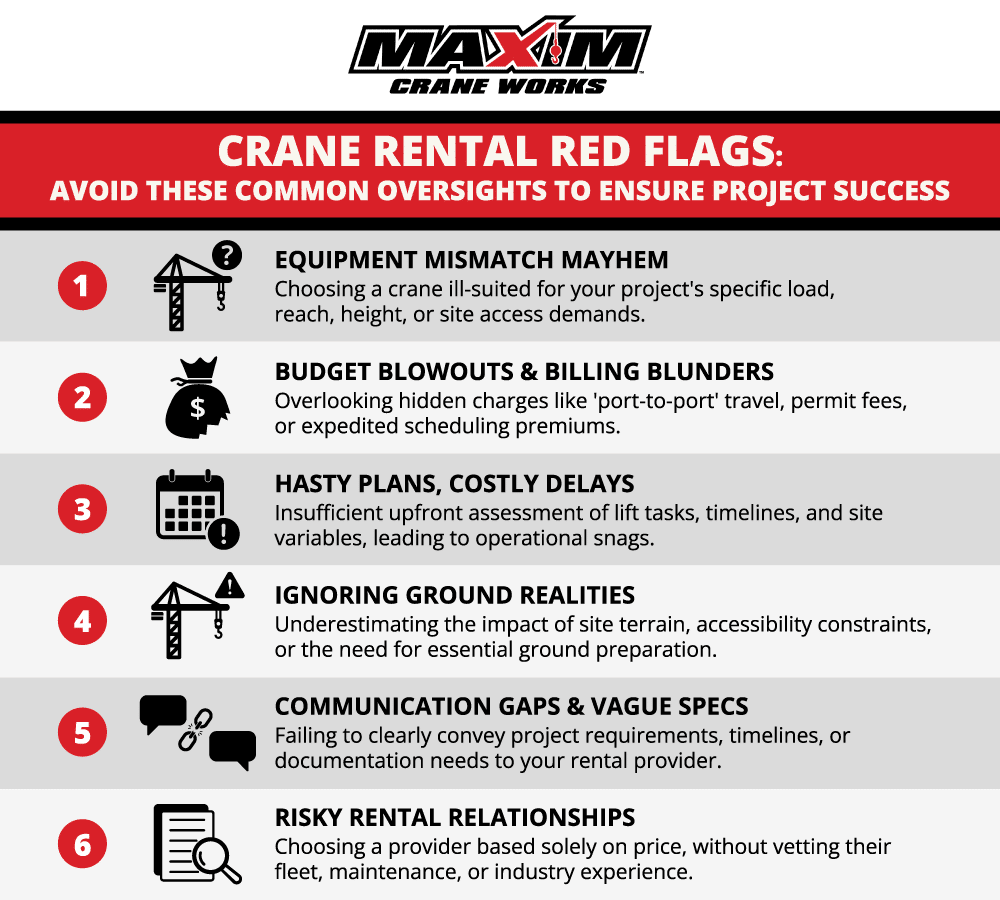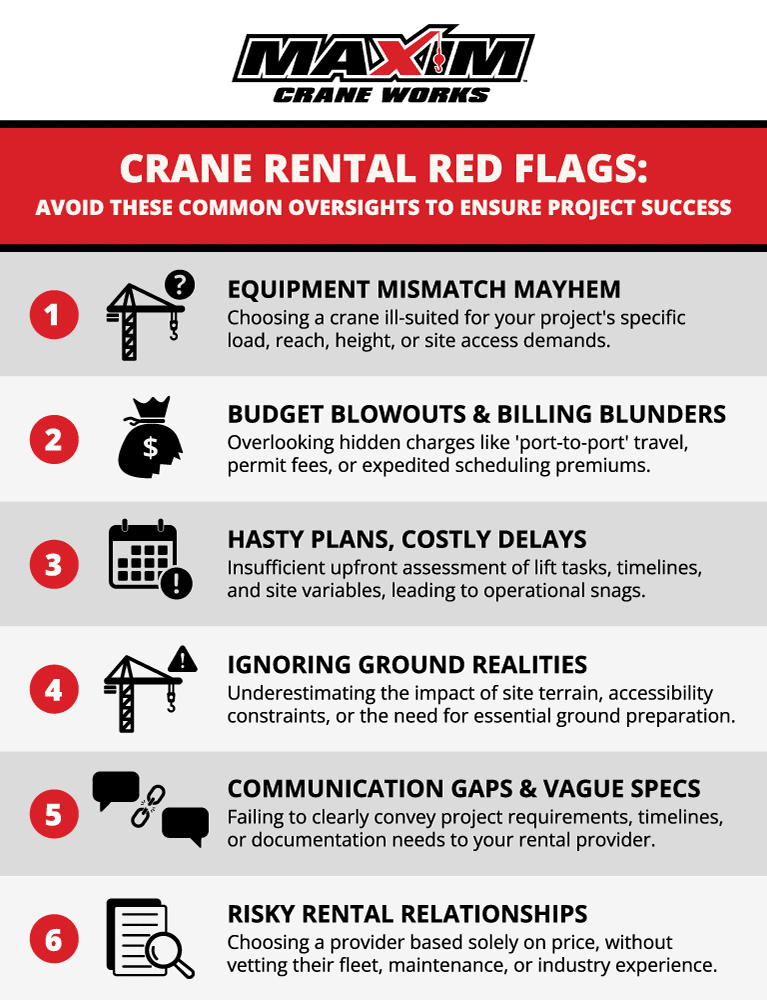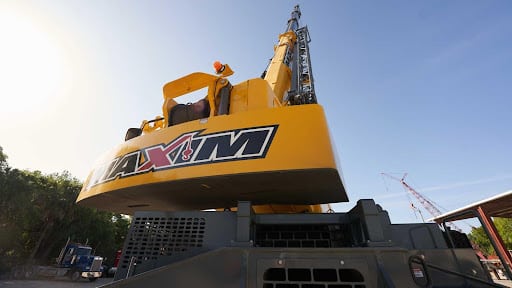Crane rentals are essential for construction, infrastructure, and industrial projects, allowing contractors and businesses to manage heavy lifting tasks effectively. These projects, often sizable in scope, benefit from the specialized equipment that rentals provide, offering flexibility without the burden of storage, maintenance, or significant upfront investment. Additionally, rentals allow access to a broad selection of cranes designed for different applications and project parameters.
Still, navigating crane rentals can be complicated. Common oversights throughout the rental process might affect schedules, raise costs, and complicate project workflows. From selecting equipment that isn’t ideally suited for the job to missing key planning steps, these types of mistakes can undermine otherwise well-structured plans. This article highlights “crane rental pitfalls” and offers practical guidance to help you address them, promoting a more efficient approach for your future projects.
Importance of Proper Crane Selection
Selecting the right crane is critical and often underestimated. With a variety of options available—ranging from all-terrain cranes, truck-mounted cranes, and crawler cranes—it is easy to feel overwhelmed. Making the correct choice helps maintain productivity, reduces downtime, and avoids inefficiencies.
Here are several factors to consider:
- Lifting Capacity: Match the equipment’s rated capacity with the heaviest load on your job site. Examine details in this lifting capacity guide to find a machine that aligns with your requirements.
- Reach and Height Requirements: Confirm the boom length and lift height are suitable for tasks like lifting items to elevated levels or spanning wide distances. Use reliable industry resources or consult with a trusted provider to plan effectively.
- Site Accessibility: Study the site’s terrain, space constraints, and entry points. Features such as tight spaces or uneven ground might point to the need for crawler cranes or other specialized solutions. Our site accessibility checklist offers useful tips.
- Project Scope: If your operations involve complex or frequent lifts, you may benefit from attachments or additional equipment. Understanding the broader project scope helps align crane selection with key objectives.
Whether you need a truck-mounted crane for quick relocations or a crawler crane for rough terrain, the challenge lies in fitting your equipment choice to your project’s specific needs. Collaboration with an experienced provider of industrial crane rentals can simplify the process by offering equipment recommendations and load charts. With a well-considered approach, you can streamline operations and avoid equipment mismatches.
Financial Considerations in Crane Rentals
It is important to understand the cost structure of your crane rental to maintain a practical budget. When you overlook certain billing components or scheduling practices, you may encounter higher costs than expected. By clarifying fees and payment structures, you promote an efficient process that supports resource planning.
Key financial elements may include:
- Travel Time or “Port-to-Port” Billing: Some rental agreements calculate charges from the moment the crane leaves the rental facility until it returns. This method, often referred to as port-to-port billing, can vary by provider. Discuss how travel time is accounted for to clarify the overall cost.
- Additional Line Items: Fees for permits, specialized equipment, or site preparation may increase the total. Request a thorough cost breakdown and confirm that your rental agreement itemizes such expenses.
- Expedited Scheduling Costs: Last-minute or high-priority requests often involve premium rates or extended-hour charges. Planning in advance helps limit these expenses.
On the financial side, early scheduling and proper coordination can help merge multiple lifts into a shorter window. This strategy utilizes resources efficiently and reduces hourly crane use. Openly communicating with a transparent crane rental company helps you map out all possible factors, plan schedules effectively, and maintain a solid financial framework.
Planning and Preparation for Crane Rentals
A thoughtful plan sets the stage for a more productive rental experience. Establishing clear objectives and timelines early on helps guide coordination, avoids wasted effort, and aligns your project with broader operational goals.
Early Project Assessment
Begin by defining your project’s specific crane needs. Consider:
- Primary Lifting Tasks: Identify load sizes, weights, and the number of lifts required. This information acts as a guide for capacity and reach demands.
- Project Timeline: Develop a schedule that includes crane availability, ground preparation, and arrival of materials or other equipment.
- Flexible Approaches: Account for variations such as possible site changes or shifting material needs. Having a plan that accommodates evolving conditions helps avert bottlenecks.
A well-structured assessment positions you to customize crane selection and planning to match project objectives.
Clear Communication with Your Rental Partner
Frequent updates and sharing of details keep both parties aligned:
- Project Requirements: Discuss weight, height, and terrain factors thoroughly so your rental partner recommends the most suitable crane.
- Practical Timelines: Agree on schedules that reflect transport times, basic on-site preparations, and potential downtime. Honesty about expected durations keeps everyone on track.
- Required Documentation: Work with your provider on any necessary permits, such as passes for public roads, so that the process proceeds without administrative slowdowns.
Constant collaboration with your rental partner helps streamline the crane’s arrival, setup, and overall usage.
The Value of Proactive Scheduling
Securing your crane rental early and grouping multiple lifts when feasible often results in a more focused schedule. This planning also allows you to avoid peak traffic hours if the job site is in a busy area.
By taking a structured approach to scheduling, you promote a cleaner workflow across all project steps. With well-organized coordination, the crane and crews remain engaged efficiently, helping your project advance according to the planned timeline.
Terrain and Site Condition Considerations
The ground conditions and layout of your work location influence which crane is most suitable. For instance, truck-mounted or all-terrain cranes move smoothly on paved or compacted areas, while crawler cranes with tracks are often better suited for uneven or soft ground.
A prepared site also contributes to a more streamlined experience. Remove loose materials and confirm that surfaces are stable and level before the crane arrives. Minor site adjustments help keep the operation running smoothly and allow the crane to maneuver more effectively.
Although it may be tempting to skip site prep steps, investing the time to address them generally reduces logistical complexity. Attention to terrain and site conditions not only aids in selecting the right crane but also helps maintain consistent progress once the project is underway.
Choosing a Reliable Crane Rental Company
When evaluating a rental company, look beyond basic costs. A dependable partner plays a prominent role in optimizing your workflow, aligning with your project goals, and readily adapting to unique on-site conditions.
A Diverse Fleet of Equipment
Providers with a broad inventory of cranes and specialized attachments can readily service everything from smaller commercial jobs to large-scale infrastructure tasks. Having options under one roof lets you choose precisely what you need, improving overall project efficiency.
Dependable Maintenance Routines
Look for a rental company that stays up to date with inspections and equipment upkeep. Properly serviced machinery typically offers consistent performance and better reliability, minimizing downtime and scheduling gaps.
Industry Experience and Guidance
A knowledgeable rental partner provides insights on crane capacities, project complexities, and equipment combinations. Their familiarity with industrial crane rentals, specialized rigging, and even engineering services can reduce confusion during the decision-making process.
Logistical Reach and Coordination
A partner with a well-developed operational footprint across multiple regions can streamline heavy hauling, equipment scheduling, and timely deliveries. Larger companies often provide added convenience when you have multi-location requirements.
Proven Expertise and Versatility
Seek providers that have successfully handled large construction initiatives, industrial frameworks, or significant infrastructure projects. This background typically indicates the resourcefulness needed for a wide variety of scenarios, whether commercial construction or intricate industrial tasks.
Tips for Maximizing Crane Rental Efficiency
Making the most of your crane rental involves anticipating project needs, communicating promptly, and maintaining a clear, adaptable workflow. Consider these approaches:
- Align Crane Delivery with Project Timelines – Schedule the crane’s arrival when materials are on-site and tasks are ready. This coordination helps you use crane time more effectively.
- Create a Detailed Lift Plan – Outline each lift in a plan that includes tasks, responsibilities, and basic sequences. Transparency helps all team members understand their roles and helps avoid confusion.
- Remain Flexible with Changing Conditions – Stay alert to shifts in the project’s timeline or material requirements. By keeping a sense of flexibility, you can adjust quickly without complicating other aspects of the job.
- Use Project Management Tools – Platforms dedicated to construction workflow can streamline assignments, equipment usage, and real-time adjustments, facilitating data-driven decisions across your team.
- Stay Connected with Your Rental Partner – Keep the rental provider informed about schedule updates or task changes. Good communication makes it easier to adjust crane selection or add relevant attachments to meet evolving demands.
For additional ideas on effective strategies, consult this guide on effectively utilizing your crane rental. With proper planning and timely communication, you can integrate your crane rental into a workflow that supports your overall objectives.


Rent a Crane with Confidence at Maxim Crane
Securing the appropriate crane for your project involves identifying equipment that aligns with your goals, addressing key cost considerations, and establishing a clear plan that supports each phase of the work. By focusing on practical strategies—like thorough assessments, proper site preparation, and strong collaboration with your rental partner—you elevate efficiency and maintain a structured approach from start to finish. Whether you’re focusing on construction projects, complex infrastructure ventures, or specialized industrial operations, thoughtful crane rental practices play a significant part in shaping the outcome.
For additional guidance or to explore how Maxim Crane Works can support your heavy lifting requirements, connect with their team of industry professionals. Their national presence, modern fleet, and experience in handling unique industrial needs may offer valuable advantages as you map out your next project.


